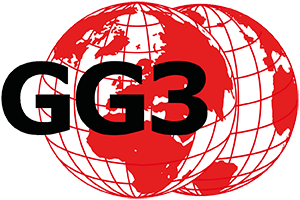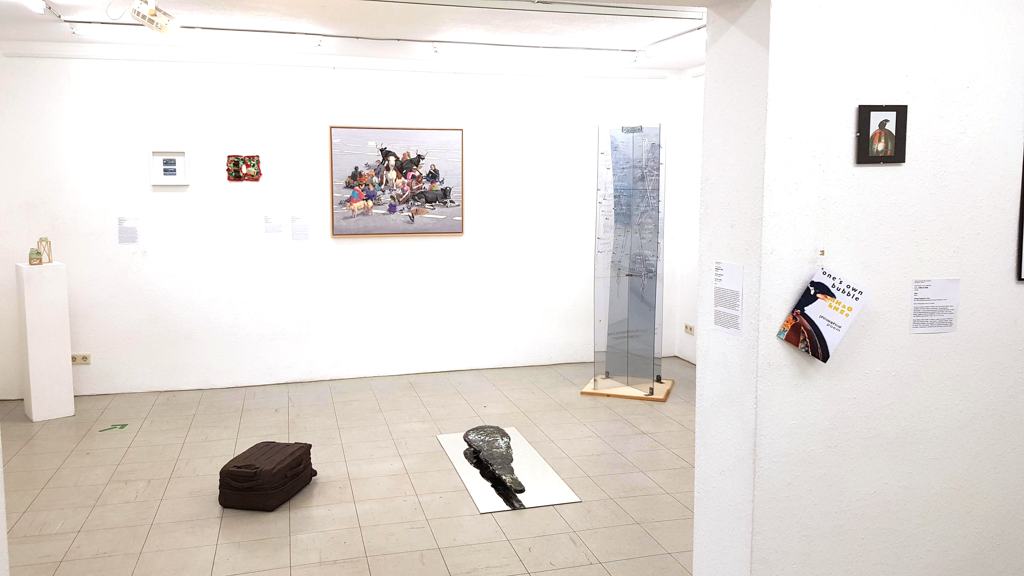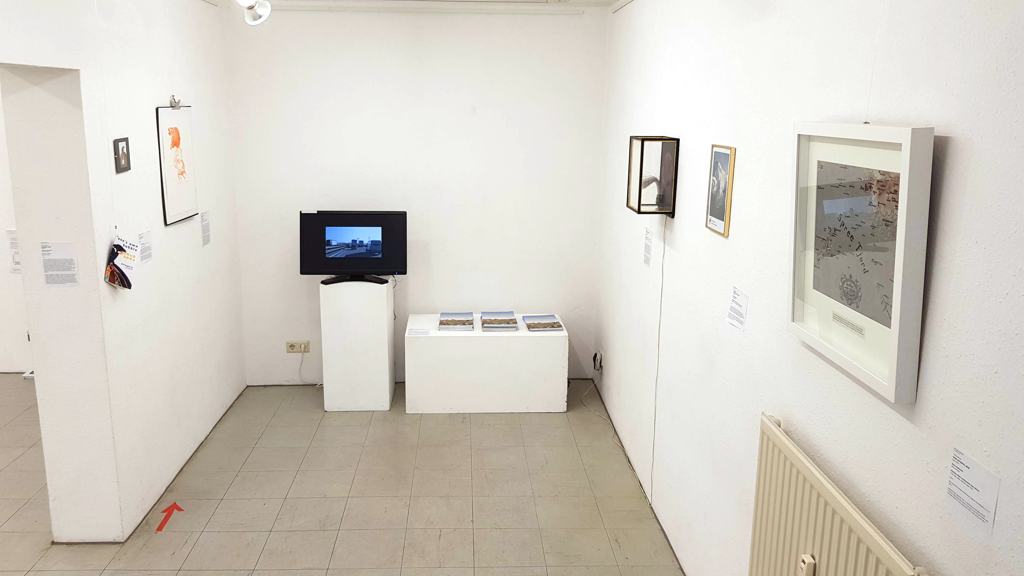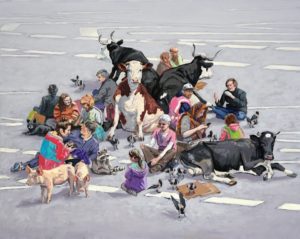International Exhibition 15.1.2021 – 12.3.2021

Friday 15.1.2021, 19:00: Video of the exhibition with guided tour by Tom Albrecht
The exhibition is open!
Click here or scroll down
To reach or not to reach the 1.5 degrees – climate target
Object, installation, photo, painting, video, reading
The 1.5 degree target is the goal of limiting the man-made global temperature increase due to the greenhouse effect to 1.5 degrees Celsius by 2100 from the level before the start of industrialization. Almost all the countries of the world have signed a treaty with the Paris Agreement, according to which they want to make efforts to achieve the 1.5 degree target. Climate researchers doubt that we will reach this target; we would already be at 2 degrees. The political will is missing. Fridays for Future fight for the adherence to the treaty.
What needs to change to achieve the goal? Researchers have developed scenarios that show ways forward. E.g. the CO2 price increases to 100€/ton. Renewable energies such as wind power, solar energy are used instead of fossil fuels. We humans live well and in a climate-friendly way.
What images do artists create on the subject? We are pleased with the many submissions and have selected exciting ones.
artists
Sandra Becker (D), Thomas Behling (D), Giulia Berra (D), Anna Dittrich (D)Volkan Diyaroglu (PL), Monika Funke Star (CAM), Yossi Galanti (IL/NL), Ian Gibbins (AUS), Stephan Groß (D), Karin Heinrich (CH), Pernilla Henrikson (D), Hartmut Kiewert (D), Maria Koehne (D), Sabine Naumann-Cleve (D), Astrid Raimann (D), Rico Rensmeyer (D), Clara S. Rueprich (GB), Berit Schmidt-Villnow (D), Maksim Shishov (RU), Technology and the uncanny (D), Tessa Teixeira (ZA), Sylvia Toy St. Louis (USA), Vaghe Stelle (Danilo Pastore, Andrea Leonessa, Alvise Zambon) (IT), Misha Waks (PL)
Video of the exhibition with introduction by Tom Albrecht
All works in the exhibition 1.5 degrees
crazy1 (2020)
Gif animation/video
We are crazy. Crazy. We are risking our planet instead of stopping global warming. My work is a warning sign, a signal to act quickly. On paper, there is an action statement with milestones. Stopping is easy once it is a political priority.
We make mobile (2020)
Photography, c-print, colored pencil, paper, glass, frame
The slogan “We make mobile. Redesigning Germany.” is in the current VW typeface “VW Head. The small map of Germany shows the landform at a sea level rise of 60 meters. If both poles melt completely, the sea level rises by about 67 meters.
Map of Berlin (2020)
Acrylic paint, paper, hardboard, glass, frame
Explanatory text below the map: This historical map still shows numerous small islands that initially existed in the area of the submerged city of Berlin after the poles melted, but which quickly fell victim to the currents and tides. If both poles melt completely, sea level will rise by about 67 meters.
Innovation and technology (2019)
Wood, glass, cardboard, photography, LEDs, LED controller, fiberglass, acrylic paint, gold leaf
On the cardboard behind the front glass pane is a small hexagonal spot – with a lot of imagination you can see the silhouette of a UFO in it. And: There are two tiny colorful points of light flashing in it. They are the ends of two optical fibers – a whole bunch of them flashing inside the box. The glass panes on the sides provide a view of this inner life – and thus also of two pictures: Planet Earth in withered colors and a black-and-white photo of a landscape with a small town settlement – the latter tilted to the side and only as the back wall of the yellowed cardboard. “Innovation and technology,” according to Angela Merkel, is supposed to have been what Greta Thunberg called for in her speech to the United Nations on Sept. 24. 2019 would have forgotten.
Terramare (2013)
Wood, glue, sea glass
On the one hand, these fragile pile houses refer to a bio-architecture developed according to nature, on the other hand, they also refer to a dystopian future in which humanity is exposed to the consequences of drought, ice melt and rising sea levels. Terramare recalls the Bronze Age settlements widespread in northern Italy, (which probably fell due to overpopulation, drought and the depletion of substantial resources), where some houses were built on stilts and others were not. And indeed, the stilts seem to wait for the water, while the superstructures made of sea glass, reminiscent of ice, show the effect of the sea on human artifacts.
Cognitive dissonance – what makes it? (2020/2021)
Recycled acrylic, spy mirror film
Every choice counts! Everything we do, feel, think and want counts! Cognitive dissonance describes the state of mind when our actions are not consistent with our thinking and values. There are many factors that influence our behavior – from monetary limits to social pressures and norms to the cost-benefit ratio. We are caught in the indecision and discomfort of the situation and must decide whether to adjust our values or our behavior. This work aims to play with this sometimes unnoticed process and make it visible and recognizable to ensure better judgment and problem solving. Most of the materials that were used came from Berlin’s old materials depots.

Apocalyptic Kebab (2012)
video
I created “Apocalyptic Kebab” first as a sculpture and then as a video in 2012, when the whole world was deliriously waiting for the Mayan prophecy about the end of the world. The situation was quite pathetic. People eagerly organized special parties for the end of the world. At that time, anything related to this subject was a real morbidity. Meanwhile, in a parallel world, scientists predicted a real world catastrophe in the near future. The world with its consumer culture, plagued by carefree people and incompetent and malicious politicians, is turning into a kebab on a spit faster than any fast food. So I had to create a symbolic and direct work about the self-destruction, despair and absurdity of our current society, where an artist can burn the whole world and everyone applauds and laughs, but if I burn a national flag they want to put me in jail.

Cameroon Kohlhaasen (2015)
Video, stick, 3 film stills
Cameroonian cabbages In Cameroon, not far from the capital Yaoundé, a new highway is being built. The hills have been cleared, the forests cleared, the residents who lived by fishing in the nearby river resettled. A lonely bush hut stands at a lofty height. One family did not allow itself to be dispossessed. The house: a monument to resistance (like Michael Kohlhaas in Kleist’s novella) against the destruction of the environment and climate.
There are no saints in this story (2020)
Video montage
The video work There are no saints in this story attempts to explore and challenge the visual language and aesthetics of the landscape painting The Saint Elizabeth’s Day Flood by the Master of the St Elizabeth Panels, c. 1490 – c. 1495. This is achieved through examining the current ecological and environmental crisis by focusing on a verity of natural and man-made disasters causing environmental degradation, such as: floods, drought, air and beach pollution, urbanization and the modern city. The work employs video footage in a surrealist approach, through a montage comprising of different scenes situated on a parallel timeline. Unlike a still image of a landscape, the video work requires a different type of attention from the viewer in order to follow the dynamics of time and motion, which provide a sense of depth to the scenery.
floodtide (2018)
Video, Digital, HD
How does a city deal with sea level rise after years of drought? How does it survive the relentless storms and floods? “Mock us, an illusion of normality … We’re out of options, we’re fighting for breath …” “Floodtide” is composed of hundreds of individual images and offers a disturbing look at a city in the near future irreparably affected by climate change.
The last measurement (2006)
Collage, digital print
The photo collage “The Last Measurement” shows a photograph of a ship’s engine sinking into an overgrown pond as if in a swamp. The displays of the measuring devices for critical operating parameters such as oil pressure and exhaust gas temperature are reflected compositionally in the blossoms of the pond plants. The gauges are intended to indicate the competencies acquired in the context of mechanization, also to quantify effects of industrial processes. It would be a sad irony of fate if mankind at the highest level of analytical development disappeared into oblivion!
Skins (2019)
Digital video, 4K, skins, ice
A group of frozen skins changes. Due to its slow, steady course, global warming is hardly perceptible as a threat to many people. Global warming is causing glaciers to disappear, permafrost to thaw, and soils to erode. Living beings lose their habitat, have to flee, become extinct. In the work “Skins”, water-soaked and frozen skins change under the influence of heat. My work shows the slow, barely perceptible decay through warming and makes this change and vulnerability visible through the time-lapse.
Batagaika (2018)
Glass, Earth / Mirror
The object “Batagaika” depicts the process of fusion of earth and glass into an elongated organic surface. The soil used comes from a soil sample taken at the Polar Research Center in Abisko, Sweden. The glass plate shows a visually seething structure on the top side, while the mirror reflects the calm counter image of the bottom side. “Batagaika” is the name of an elongated giant crater, which was suddenly discovered in the 60:s near the village of Batagay, in northwestern Siberia. The background for this is the continuous melting of the permafrost, caused by global warming. The resulting destabilization of the soil causes a massive release of carbon dioxide and methane gas, which in turn causes underground explosions and thus deep craters.
Study on No Cars Go (2020)
Oil on canvas
The predominance of individual automobile transport is one of the main drivers of planetary heating. Apsphalt gobbles up space in cities and eats through intact forests, such as the Dannenröder Forest. In the painting “Study of No Cars Go,” humans, raccoons, and hooded crows, along with cows and pigs escaped from fattening plants and slaughterhouses, occupy a site dominated by automobile traffic. Transportation reversal and animal agriculture repeal, which are central to addressing the climate crisis, intertwine in this picture. The climate crisis is the result of unchecked domination of nature and animal exploitation. We need to develop a different relationship with nature and other animals and ask the question of who dominates which places and who is banished to which places, displaced, shot out or shot in. #reclaimthestreets
o.T. (1996 & 2020)
Analog photography C-Print
A beo casting a black shadow sits on a globe whose surface is no longer intact. Climate change – water scarcity – species extinction — as man-made heating progresses, so does the likelihood of human extinction. “One’s Own Bubble” as a book reflects the possibility to breathe, to relate to oneself, to establish a reference to what is w i r k l i c h .
Cool down Earth (2020)
Plastic, felt pen
What it’s all about: Reducing CO2 emissions in the private sphere. The map serves as a fictitious record of all private CO2 emissions of a person, as one of many possible measures on the way to climate neutrality. The QR code is an important part of the work and connects the map with the website www.naumann-cleve.de. There you can read my vision of how CO2 reduction towards climate neutrality can be regulated in a globally fair way in the private sector. The chip stores all private CO2 emissions. The initial print run is 100 copies. When this card is purchased, the first name, last name and card number are individualized accordingly. The card costs 50 €. 10% of the ticket price goes to the non-profit association Primaklima, which has been actively involved in climate protection since 1991 and plants trees to preserve and increase forests.
MOSCHBERG – Pictures from the Future (2016)
Graphic novel (drawing), video
Stopping climate change means changing your life. A small town in the Sauerland region before – after: the people of Moschberg have transformed their town into a livable and thriving place. MOSCHBERG shows what that looks like and what it feels like to live in a Transition Town. You see what you can do and how beautiful and alive it is. With Leo and Mona you experience what is fun about the ecological turnaround, but also where it is difficult. And how it can succeed when society and people change.
Homeless turtle (2020)
Acrylic on canvas
What does it mean to have a home and what does it mean to have to go in search of a new home? Climatic conditions have always caused animals and people to leave their familiar surroundings. A large part of humanity has become sedentary. Moving is a very inconvenient thing, especially when you are forced to do it. It means to be almost defenseless for that moment. Change is a natural part of life. But they can also occur so quickly that flora and fauna cannot adjust to them. The massive intervention of man in nature will cause great changes. How quickly and how strongly they occur depends on ourselves. Be prepared for it, because it has already begun!

FROTH (2016)
HD video, color/sound
A rocky coast, a lifeless body in the sand: a nature morte is sketched in a few intense shots. Flies shimmer like gems in close-up, their busy movements across nostrils and teeth dominating the image for a long time before the tide comes in and a tenacious struggle with the heavy carcass begins. The video is an elegiac exploration of the interplay between sea and death. At a time when flood disasters are becoming more frequent and sea levels are rising, the film uses haunting, slow-moving images to point to the sense of being at the mercy of nature, which is not suspended even by high-tech.
Stay on the ground! (2020)
Clay, fired
Travel is great. We all love it. But we have to think about it. Air travel contributes significantly to the climate crisis. This board case stands as a symbol of air travel. Its material and the defective roller counteract its original purpose, it stands on “feet of clay”. Everyone can contribute to improving the climate by consciously reducing such travel. So that we manage to limit global warming to below 1.5°C.
AGREEMENT ARE IMPORTANT BUT AGREEMENT ARE NOT IMPORTANT (2020)
Prints, glass frames, blinds
This work is about non-compliance with the provisions of the signed Paris Agreement. Accordingly, it is necessary to reduce CO2 emissions, which many countries are not doing. These two windows serve as triggers for those who ignore the convention. You want to look out the window, but your signature and your business are tormenting you. Most governments still live by the Louis 15 rule of “Après nous le déluge” (After us, the deluge). It is an interactive work that you can interact with. It simulates two windows that are equipped with blinds. When the blinds are raised, a person becomes familiar with the content of the work. But blinds should always be hung. Each person should open the curtain and not immediately see the result.
T+U vol. V. ICE (2018)
Fanzine, digital print on paper, first edition of 150 copies
The fifth volume of the fanzine T+U ICE aims to describe our contemporary technocultural conditions by exploring the semantic ecology of certain thermodynamic metaphors related to cooling, freezing, ice formation, crystallization and, conversely, heating and melting. This metaphorical inquiry also relates to A. Gehlen, who in his text On Cultural Crystallization claims that we have arrived in a post-historical era in which modern culture has entered a crystalline state. The vision of frozen history refers to a new cultural ice age in which the production of commodities ceases while every previous form of knowledge is put to rest. At the heart of this frozen posthistorical delay, however, deadly forms of acceleration also proliferate.
#2 Degree Celsius (2020)
Sugarlift aquatint etching – 1 color – edition of 10
Biologist David George Haskell writes, “We are all – trees, humans, insects, birds, bacteria – pluralities. Life is embodied network. These living networks are not places of omnipotent unity. Instead, ecological and evolutionary tensions between cooperation and conflict are negotiated and resolved. My etching issue ‘#2 Degree Celcius’ is inspired by Haskell’s proposal and responds to current secondary scientific research on elevated global temperatures affected by human activities, including the burning of fossil fuels that increase global greenhouse gas emissions. We are already at 2 degrees Celsius and seeing more frequent and intense wildfires, droughts and storms around the world. The etching process used reflects the tension between cooperation and conflict. between the

THE SELF-MADE FALL by Sylvia Toy: 12 – tick t ick tick (2020)
Video (human, plastic, lipstick)
This video is number 12 in a protest / action series about plastic pollution, THE SELF-MADE TRAP by Sylvia Toy. We must stop !!! USE PLASTIC because: #1 Plastic is made from fossil fuels, our murderous addiction; #2 Plastic will suffocate us humans and kill us like it will the kill oceans.

One Point Five (2020)
Music and video art contribution consisting of: – the intuition of an opera singer; – the creativity of a composer; – the knowledge of an audio technician; – the vision of a video artist.
One Point Five (the goal of the Paris Agreement to limit the greenhouse effect) is an attempt at a musical translation of the drama of contemporary man, inserted into an environment that responds to all these actions in the name of progress. Each vocal gesture of the piece of music, composed specifically for the occasion, corresponds to another that responds to the first and persists over time, helping to change the sound environment in which it is immersed. This creates a saturation, both from an acoustic and visual point of view, that becomes unsustainable and can only pulverize in the void of a desperate cry: “It’s a disaster”, the thought slogan of G. Monbiot, reported in the famous article “Grand promises of Paris climate deal undermined by squalid retrenchments”, appeared in The Guardian of 12/12/2015.
GAME OVER (2020)
Ready-made, plastic, paper
“The game is up” In a trash can in Berlin I found an old Monopoly game. I have subjected it to thermal treatment. The game we have been playing for so many years is coming to an end. We can already see the symptoms, the temperature level is one of them. Nevertheless, we keep playing it all the time. Until one day the board becomes unusable and we end up with it in the dustbin of history.
Overview
program
Since the corona crisis still requires restrictions, we will adjust the exhibition organization and program accordingly. We plan analog in space and present digitally. Our gallery will be reopened after the lockdown. To participate online, please look here. We will show a commented video tour and the works after the opening.
Opening Jan. 15, 2021, 7 p.m.: online video and online gallery
Artist talk Feb. 5, 7 p.m. online in dialogue for artists in the exhibition and guests via a jitsylink we show here at 18:45. Crome or Forefox browser is enough to participate.
Lecture “Achieving the 1.5° Climate Goal. Transformation in Germany, Role of Art”, Steffen Krenzer (Co-Author Handbook Climate Protection, Environmental Psychologist) Feb. 12, 7 p.m. online.
Closing Fri. 12.3, Astrid Raimann and her work.
7 pm We recommend the video:
” Moschberg. Transition Town. Pictures from the future”
19:12 GG3-Online conversation about the video with Astrid Raimann, author of the video. You are welcome to join the conversation about the Jitsylink as guests. Chrome or Firefox browser will do.
52. exhibition 1.5 degrees
Place: 10999 Berlin, Leuschnerdamm 19
Jury and curators: Team GG3
2023: Exhibition of the same name at the Kunsthalle Mannheim

























